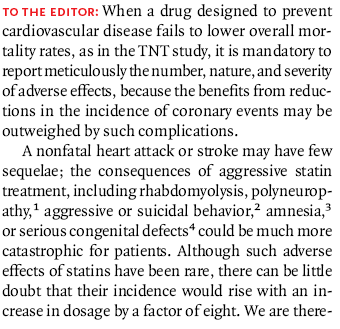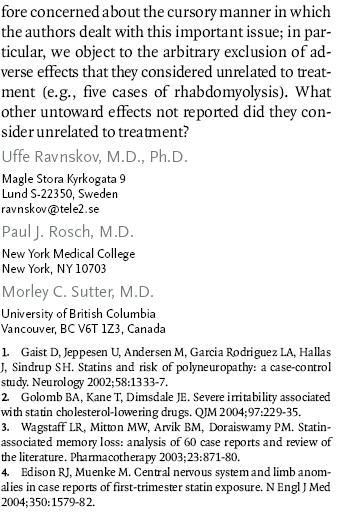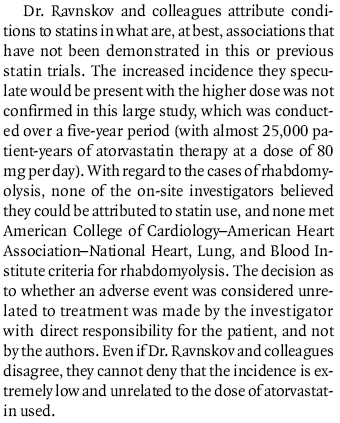|
This is a
contribution from members of THINCS, Letter; N Engl J Med 2005;353:94.
The authors´ response:
Our
comments The
authors failed to elaborate on their criteria for determining whether a side
effect might have resulted from atorvastatin.
For instance, how can the authors conclude that the five cases of rhabdomyolysis
occurring during treatment were not due to atorvastatin? Rhabdomyolysis is a
recognized complication of statin therapy that led to the withdrawal of
Baycol because it is otherwise extremely rare. The fact that the incidence
was unrelated to dosage is hardly a supportive argument. To determine
whether a side effect is dose-dependent is impossible judged from five cases
only. More specific
information about other possible adverse responses to atorvastatin was not
supplied either as requested. In particular, only the number of patients
with persistent elevation of aminotransferases over three times the upper
limit of normal were listed (eg. 51 more cases in the high-dose group).
Why not give the number of any persistent elevation as is customary
in pharmaceutical trials? Could the explanation be that the number of
patients with this indication of liver damage by far outweighted the benefit
of 65 fewer non-fatal heart attacks? Even
if the number of side effects given were true, there is reason to believe
that the number was much smaller than it would be in clinical practice. At
first more than 3000 of the patients originally selected for the trial were
excluded, some of them because they did not fulfil the criteria, others
because of elevated aminotransferases, or because of cancer or another
disease associated with a limited lifespan, or because of “other reasons”.
Following
a 1-8 week period of treatment with low dose atorvastin, an additional 5461
patients were rejected, including 197 with adverse events, 70 who did not
comply with the treatment, 195 who had ischemic events, 16 who died during
this short period, and 349 “for other reasons”.
No information is provided on the nature of these side effects or
causes of death. Similarly, it
is not clear what side effects “related to treatment" later caused
7.2% to stop the treatment.
(The lack of elaboration on this is not unusual since in other statin
trials up to a fourth of the patients stopped medication for reasons that
were not disclosed.) Finally, of the
18,469 patients originally screened, only 10001 were selected, thus
representing a cohort of much healthier participants than would be treated
by clinicians. In
addition, atorvastin's manufacturer, Pfizer, funded the trial, analyzed the
data, did not allow outside access to this information and one of the study
authors was a Pfizer employee. The
FDA recently cited Pfizer for publishing the results of a valdecoxib trial
in a manner that obscured the risks and the drug now has a black box
warning.1 Pfizer also pleaded guilty on 13 May 2004 to numerous charges for
illegally promoting the off-label use of gabapentin and agreed to pay
$430 million to satisfy criminal and civil penalties.2 It
also seems strange that the methodology of the 5-year long TNT trial3
was not published at the start of the trial instead of four years later.
Even more amazing was the availability of the TNT trial report on the
journal´s website on March 8 if all the eleven authors did not have access
to the data until January 29? To write this 11 page report, to check all the data, and to
get it peer-reviewed and published in less than six weeks is simply a case
for Guiness Book of Records. 1.
Lenzer J. Pfizer
pleads guilty, but drug sales continue to soar. BMJ 2004;328:1217 2.
Lenzer J. Pfizer
criticised over delay in admitting drugs´ problems. BMJ 2004;329:935 3.
Waters DD, Guyton JR, Herrington DM,
McGowan MP, Wenger NK, Shear C; TNT Steering Committee Members and
Investigators. Treating to New Targets (TNT) Study: does lowering
low-density lipoprotein cholesterol levels below currently recommended
guidelines yield incremental clinical benefit? Am J Cardiol. 2004
Jan 15;93(2):154-8. |



